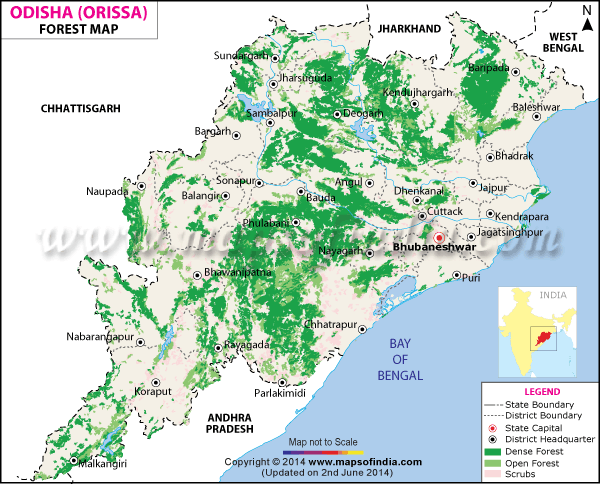

The ancient kingdom of Kalinga,
which was invaded by the Mauryan emperor Ashoka
(which was again won back from them by king Kharavela) in 261 BCE resulting in the Kalinga War,
coincides with the borders of modern-day Odisha.
Three-quarters of the state is covered in mountain ranges.
Deep and broad valleys have been made in them by rivers.
These valleys have fertile soil and are densely populated.
Odisha also has plateaus and rolling uplands, which have lower elevation than the plateaus.
According to a Forest Survey of India report released in 2012,
Odisha has 48,903 km2 of forests which cover 31.41% of the state's total area.
The forests are classified into: dense forest (7,060 km2), medium dense forest (21,366 km2),
open forest (forest without closed canopy; 20,477 km2) and scrub forest (4,734 km2).
The state also has bamboo forests (10,518 km2) and mangroves (221 km2).
The state is losing its forests to timber smuggling, mining, Industrialisation and grazing.
There have been attempts at conservation and reforestation.

2 National Parks and 18 Wildlife Sanctuaries
Due to the climate and good rainfall, Odisha's evergreen and moist forests are suitable habitats for wild orchids. Around 130 species have been reported from the state.[59] 97 of them are found in Mayurbhanj district alone. The Orchid House of Nandakanan Biological Park hosts some of these species.
Non blandit massa enim nec dui nunc mattis enim ut. Cursus in hac habitasse platea dictumst quisque sagittis purus Lorem ipsum dolor sit amet, consectetur adipiscing elit, sed do eiusmod tempor incididunt ut labore et dolore magna aliqua. Adipiscing commodo elit at imperdiet dui accumsan sit. Ipsum dolor sit amet consectetur adipiscing elit. Integer quis auctor elit sed. In pellentesque massa placerat duis ultricies. Interdum consectetur libero id faucibus nisl tincidunt. Condimentum mattis pellentesque id nibh tortor id aliquet
Sukun